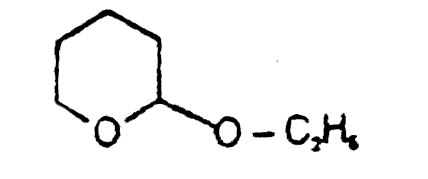Select the compound in which HCl is not the product of Hydrolysis:
NCl3
PCl3
AsCl3
BiCl3
The correct Answer is:A
To solve the question of selecting the compound in which HCl is not the product of hydrolysis, we will analyze each compound one by one and observe the products formed when they react with water.
1. Understanding Hydrolysis: Hydrolysis is a chemical reaction involving water, where water reacts with a compound to produce new substances. We are specifically looking for a compound that does not produce HCl upon hydrolysis.
2. Analyzing the First Compound (NCl3):
- When NCl3 (Nitrogen trichloride) reacts with water, the reaction can be represented as:
NCl3+H2O→NH3+HOCl
- In this reaction, the products are NH3 (ammonia) and HOCl (hypochlorous acid). Notably, HCl is not formed.
3. Analyzing the Second Compound (PCl3):
- When PCl3 (Phosphorus trichloride) reacts with water, the reaction can be represented as:
PCl3+H2O→H3PO3+HCl
- Here, HCl is produced as one of the products.
4. Analyzing the Third Compound (AsCl3):
- When AsCl3 (Arsenic trichloride) reacts with water, the reaction can be represented as:
AsCl3+H2O→H3AsO3+HCl
- Similar to PCl3, HCl is also produced in this reaction.
5. Analyzing the Fourth Compound (BiCl3):
- When BiCl3 (Bismuth trichloride) reacts with water, the reaction can be represented as:
BiCl3+H2O→BiOCl+HCl
- Again, HCl is produced in this reaction.
6. Conclusion: After analyzing all the compounds, we find that:
- NCl3 is the only compound that does not produce HCl upon hydrolysis. Instead, it produces NH3 and HOCl.
Final Answer:
The compound in which HCl is not the product of hydrolysis is NCl3.
- When NCl3 (Nitrogen trichloride) reacts with water, the reaction can be represented as:
NCl3+H2O→NH3+HOCl
- In this reaction, the products are NH3 (ammonia) and HOCl (hypochlorous acid). Notably, HCl is not formed.
- When PCl3 (Phosphorus trichloride) reacts with water, the reaction can be represented as:
PCl3+H2O→H3PO3+HCl
- Here, HCl is produced as one of the products.
- When AsCl3 (Arsenic trichloride) reacts with water, the reaction can be represented as:
AsCl3+H2O→H3AsO3+HCl
- Similar to PCl3, HCl is also produced in this reaction.
- When BiCl3 (Bismuth trichloride) reacts with water, the reaction can be represented as:
BiCl3+H2O→BiOCl+HCl
- Again, HCl is produced in this reaction.
- NCl3 is the only compound that does not produce HCl upon hydrolysis. Instead, it produces NH3 and HOCl.
The compound in which HCl is not the product of hydrolysis is NCl3.
Topper's Solved these Questions
- TYPES OF REACTIONSBOOK - VK JAISWAL ENGLISHCHAPTER - TYPES OF REACTIONSEXERCISE - LEVEL 3
44 Videos
- TYPES OF REACTIONSBOOK - VK JAISWAL ENGLISHCHAPTER - TYPES OF REACTIONSEXERCISE - ONE OR MORE ANSWERS IS/ARE CORRECT
40 Videos
- TYPES OF REACTIONSBOOK - VK JAISWAL ENGLISHCHAPTER - TYPES OF REACTIONSEXERCISE - SUBJECTIVE PROBLEMS
42 Videos
- s-BLOCK ELEMENTSBOOK - VK JAISWAL ENGLISHCHAPTER - s-BLOCK ELEMENTSEXERCISE - SUBJECTIVE PROBLEMS
2 Videos
Similar Questions
Knowledge Check
White phosphorus reacts with chlorine and the product hydrolyses in the presence of water. Calcualte the mass of HCl obtained by the hydrolysis of the product formed by the reaction of 62 g of white phosphorus with chlorine in the presence of water.
A200 gB400 gC219 gD100 g
End products of protein hydrolysis are
View SolutionWhite phosphorus reacts with chlorine and the product hydrolyses in the presence of water. Calcualte the mass of HCl obtained by the hydrolysis of the product formed by the reaction of 62 g of white phosphorus with chlorine in the presence of water.
View SolutionSelect the correct answer from the choice given in brackets :
The functional group of the product formed - on hydrolysis of bromoethane with aqueous caustic potash. [alcohol, carboxylic, hydroxyl, aldehydic]
View SolutionWhat are the products of hydrolysis of maltose?
View SolutionWhat are the products of hydrolysis of lactose?
View SolutionWhich of following gives only basic product on hydrolysis :-
View SolutionWhat are the products of hydrolysis of lactose ?
View Solution

